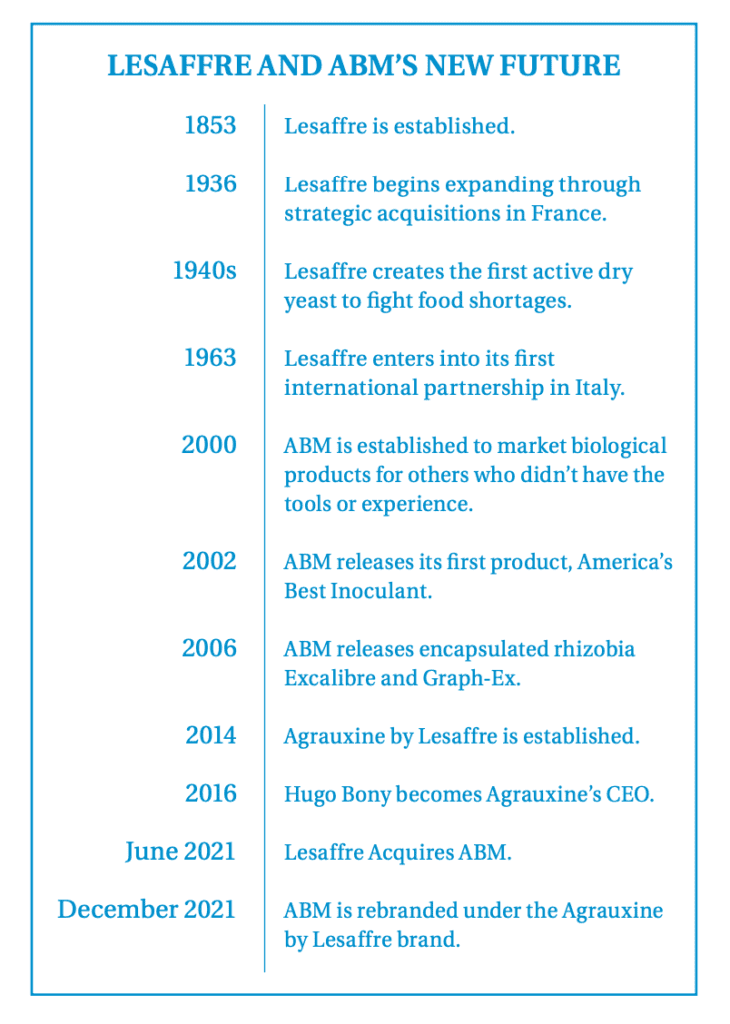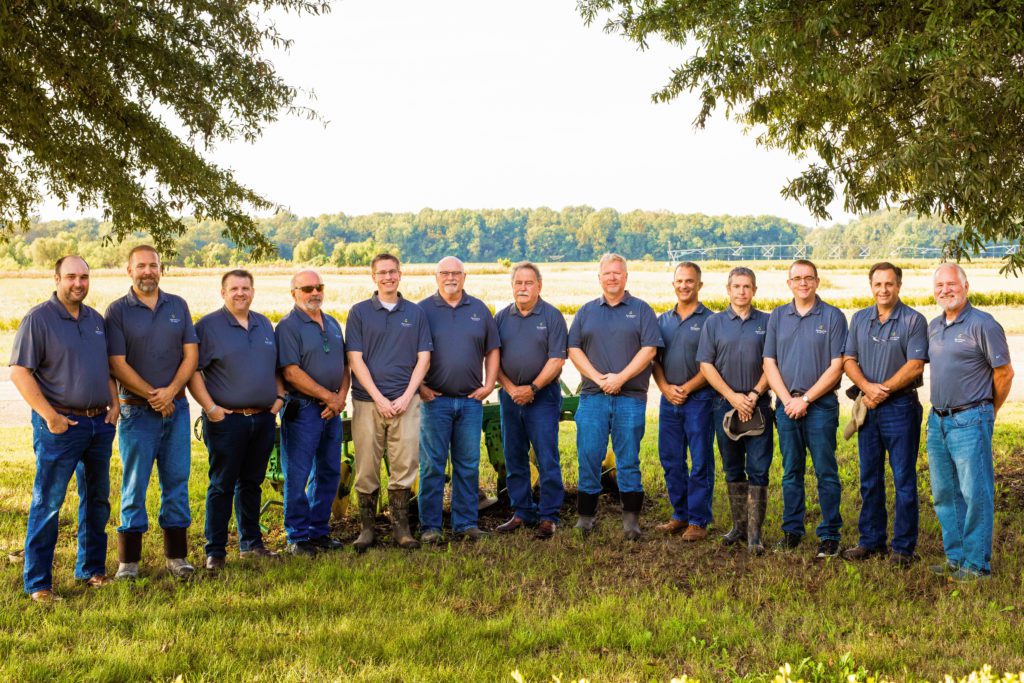As ABM transitions to the Agrauxine by Lesaffre brand, both companies reiterate that change won’t affect customer service.
There’s one word that’s sure to throw everyone off their balance. It’s not really a good or bad word, but it brings an unpredictable air with it. For some, it might be exciting. For others, it might drive up anxiety.
Change.
Did it excite you? Did it terrify you?
Change comes with life, and while it might have a slight negative connotation around it for some, ABM is excited to see what new challenges and opportunities change will bring as they transition under the Agrauxine by Lesaffre brand.
Lesaffre’s Legacy
While Lesaffre might not be a name that the U.S. seed industry is familiar with, it’s a name that comes with a great history and long legacy. Established in 1853, Lesaffre supports bakers and cooks across the globe, whether you know it or not. How? Well, Lesaffre’s best known as a global player in the fermentation industry — particularly in the yeast industry.
“Basically, there’s one bread out of three in the world that is baked using Lesaffre’s yeast,” says Hugo Bony, CEO of Agrauxine by Lesaffre, the business unit of Lesaffre dedicated to biosolution products. “It’s quite the significant success story and it’s been managed due to the mastery of the industry.”

And even after 170 years in the business, deep down, Lesaffre is still a family company.
Lesaffre was built due to a friendship between Louis Lesaffre and Louis Bonduelle who launched the company’s first grain alcohol and gin plant in Marquette-lez-Lille, France. The two, encouraged by a new Austrian fermentation process, began manufacturing baker’s yeast, which has been the company’s emblem to this day.
From there, the company expanded during World War II to perfect yeast-based production and created the first active dry yeast to offset food shortages. Soon after, the company launched Saf-Instant, the industry’s first instant dry yeast product.
While yeast is the company’s emblem, Lesaffre has been expanding. From challenges of a massive fire, a grain alcohol crisis and World War II’s occupation of France, Lesaffre learned that agility and innovation needed to be top-of-mind.
To continue to innovate, Lesaffre began to expand their knowledge base. And thus, in 2014, created Agrauxine by Lesaffre to expand further into the plant science realm. Agrauxine’s expertise falls into anything related to biologicals — foliar, seed treatment and more.
“These business units, as we call them, have been around for at least half a century in some form or fashion to leverage the power of microorganisms,” Bony says. “At first it was yeast focused, but has developed into bacteria and fungi. Now, business units are looking at microbes in humans and animals.”
However, it was only in the last 20 years that Lesaffre began working in the plant industry.
“Specifically, the group wanted to look at how our products could be used around plants,” he says. “That’s why the business unit Agrauxine was created — to put together some research jobs done internally for a handful of years and to pull new startups together to create a biosolution company.”
Bony was brought into the company with the establishment of Agrauxine as well.
“Originally I joined Lesaffre to look at competitive intelligence and corporate development,” Bony says. “In 2014, the group asked me to take leadership of the business unit about a year and a half after its creation in 2016.”
“This division of staff creates Agrauxine as an industrial and technical player in the field of biosolutions,” says Ronan Kempf, head of marketing and development at Agrauxine. “We have a portfolio of biologicals coming from our fermentation used as biofungicides, biostimulant andbionutrition with an initial focus on the European and Latin markets.”
When it came to expanding, Kempf says there was only one clear path: the U.S. market. Why? Currently, the U.S. market is the largest biological market in the world and would provide Agrauxine with good market access and R&D as well.
Expanding Innovation with Acquisition
While Agrauxine’s footprint is global, the company needed to get a foothold in the U.S. — and what better way to gain one that’s already well respected and established?
“We believe it’s important to be in a position to address all the farmer’s needs at all the different crop stages, so they can find some balanced solutions along the way,” Bony says. “Of course, that starts with the seed, and then moves along with the crop as it grows and continues to postharvest.”
ABM brought in a strength that Agrauxine lacked — the connection to the seed sector of the industry.
“When you look at ABM, they were actually active on the bionutrition segments — meaning all the inoculants and products you’d apply on the seeds,” Bony says. “On top of that, they had some fungicides, bionematicides and bioinsecticides, which were fields that we weren’t actively pursuing.”
When you put that all together, with the ability to develop and use products coming out of fermentation — which of course, ties in well to the Lesaffre group’s history with fermentation and yeast — ABM seemed like a good fit into the Agrauxine family.
In addition, though, Bony says ABM provided a new set of crops to work with. Previously, Agrauxine was focused on specialty crops. Think crops more in grape, orchard and vegetable sector. Meanwhile, ABM has a strong focus on row crops — particularly corn and soybean.
“They had the access to the market knowledge on row crops, and that’s a huge advantage when we try to develop our biostimulant, Smartfoil, on row crops,” he says. “When you bring all those aspects together, we can bring that biostimulation to different stages of a wide variety of crops. It was really a perfect fit for us, and it accelerated our own development.”
At the end of the day, Kempf says as a group they’ve been able to deploy 150 new products in 35 different geographies in less than four years.
“The acquisition of ABM is quite a strong investment for us to deliver better structure, project management and products to customers,” he says.
Same Faces, New Opportunities
But, for customers, change is still intimidating and unpredictable. One question many may wonder: How is this going to change my operation or my business?

According to Kempf, yes, there will be change, but it’ll be a change in opportunities. When it comes to customer service, there will be no interruptions or changes.
“We invest a lot of energy in understanding what our product and our customers need to be successful in the market,” says Kempf. That means, energy goes into making field trials and ensuring all employees are specialists in what they do. “All this R&D ensures is that when customers use our product, they’re going to experience the same thing every time.”
In particular, Bony is most excited about the focus on the U.S. market.
“There will be plenty of international opportunities coming with it, of course, but we’re excited about the opportunities in the Pacific Northwest,” says Bony.
This opportunity, though, is twofold, Bony says. Previously, ABM products were not sold in all states and were more focused on the Midwest — now, there’s a way to accelerate that commercial development.
“When you’re a small company, it’s just not possible to sell everywhere,” he continues. “Now, we can work together to accelerate their commercial development with untapped opportunities in tandem with the launch of Smartfoil.”
When it comes down to it, this isn’t just a one-way street for Agrauxine — ABM is excited about falling under the Agrauxine brand for the new opportunities it brings both companies.
One major change you’ll see to ABM is a name change — instead, ABM will now be under the Agrauxine brand as Agrauxine by Lesaffre.
“A brand is much more than a logo or a tagline,” says Pete Hayes, vice president of marketing for Agrauxine in North America. “It’s who you are as a company. That means all the way from our sales staff to customer service to our production staff, everyone is part of that brand and public perception of your company.”
For Hayes, branding is one of the most important things a company can do — and Agrauxine has given ABM a chance to rebrand under the Lesaffre group to become a part of the company’s long legacy.
“Both companies are family owned and hold integrity and trust above everything else,” he says. “So, it’s only the name that changes, and of course, our messaging will change a little as two companies come together. But, the general principles of our two companies are very much aligned.”
Kempf says that with that, they work to ensure consistency in every product.
“The key is we bring the right promise,” he says. “You don’t want to overpromise or under promise what a product or service can do — if you give the right promise, then a product can perform really well.”
Opportunity-wise, Chris Thrasher, director of sales of Agrauxine in North American, says it’s exciting to be able to collaborate with the other business units under the Lesaffre brand.
“At ABM, we were really isolated as an independent company,” Thrasher says. “Now, we still operate as an independent company, but we have a massive organization behind us that we can share and collaborate with to bring knowledge, expertise and experience to the field.”
With that new expertise, of course, comes new products — and while the ABM portfolio will still exist and be available, it’ll be enhanced with the Agrauxine portfolio.
“While the name changes and the brand taglines may change, customers are still going to be working with products manufactured out of Ohio,” Hayes says. “Although, there’ll be some new product additions, your salesman will stay the same, along with the customer service.”
“Everything starts with the seed,” says Thrasher, “but there’s a lot that can happen from planting to harvest. Our business runs everything from seed to post harvest, and now, we can stand in the field and guarantee that we’re here to help our customers throughout the growing season.”
In addition, Thrasher is eager to work with the high value (vegetable, grape or orchard) side of the industry.
“A few months ago, I was down in Florida,” he says. “When you’re standing there with a vegetable producer that has lost all their controls due to regulation, they get excited when you offer them a biological that can do the same thing. Seeing a grower get excited about having a solution for a problem makes everything worthwhile, and that wasn’t something we could offer to the specialty growers before.”

Creating a New Level of Expertise
While faces might stay the same, if you’re working on a new side of the industry — say the vegetable side of the industry — you might see some new additions to the Agrauxine in North America team.
Agrauxine is working to create a higher level of expertise with team members who are specialized in specific fields of biologicals.
“ABM has passionate people on their team, but we want to bring in more support,” says Kempf. “A more strategic approach will let them express their expertise more.”
This approach, Kempf says, will help all employees focus on what they’re good at and give them time to perfect their work.
In addition, Thrasher says this is an exciting opportunity for ABM employees, as this provides a new challenge to their staff.
“It’s a learning curve,” he says. “When you look at my team, a lot of them are very seasoned employees and members. Now, you’re giving them a new challenge — we’ve figured out the seed treatment industry. Now, we’re going into more of a broader spectrum.”
But, if you notice changes in the staff, Thrasher says it’s not a thing to worry about.
“We’ll be more specialized, more defined in what our responsibilities are,” he says. “Being a small company before, employees had to wear multiple hats.”
As an example, Thrasher mentions his tech service director was also a salesman and a manager on top of that.
“Now, we’re able to take some stuff off their plate and let them focus on really owning what their specialties are,” he says. “The plan is to add more assets in the field to help position products.”
In the end: while change can stir up anxiety more often than not, a change like this isn’t something to be worried about.
“When you have this big amount of change coming in, there’s a really big sense and feeling of losing control, and our natural reaction is to resist the unknown,” Thrasher says. “But the biggest thing I’ve been coaching everyone is: our team members are the assets. Not the name on the building — the employees.”
That will continue to be the biggest driver for Agrauxine in North America as this acquisition process continues to develop: the people will continue to be the focus. Not just employees, but customers as well continue to be top-of-mind and the biggest concern.
Don’t let change intimidate you: while it’s an unknown, it’s leading to an exciting new beginning.
Want to hear more from the North American side? Check out this Giant Views with Chris Thrasher.
Want to Read More? Check out:
Trust is the Building Block of Company Culture













